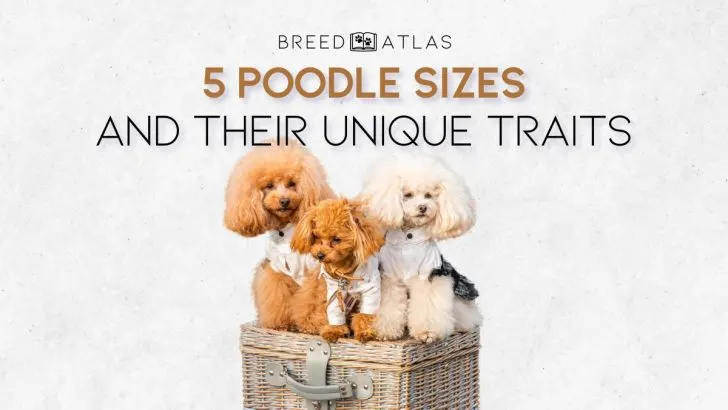Everyone loves Poodles! These highly intelligent dogs seem to be everyone’s cup of tea. And speaking of cups – did you know there are several Poodle sizes you can choose from? Oh, the joy!
Many people know that poodles can be big and small. But what about all the sizes in between?
Believe it or not, there are 3 ‘official’ Poodle sizes, and a few more that the AKC doesn’t recognize, but you’ve probably heard of.
So, what’s the deal with all these types of Poodles? Are they different in size only, or is there more than meets the eye?
Let’s find out together!
Poodle Size Chart

Before we begin, this Poodle size chart can help you see all the different sizes at a quick glance:
| Height | Weight | |
|---|---|---|
| Standard | 18 – 24 inches | 45 – 50 lbs |
| Moyen | 15 – 20 inches | 15 – 35 lbs |
| Miniature | 10 – 15 inches | 10 – 15 lbs |
| Toy | 7 – 10 inches | 6 – 8 lbs |
| Teacup | 5 – 7 inches | 3 – 8 lbs |
| Lifespan | Recognized by the AKC | |
|---|---|---|
| Standard | 12 – 15 years | Yes |
| Moyen | 12 – 15 years | No* |
| Miniature | 13 – 15 years | Yes |
| Toy | 12 – 14 years | Yes |
| Teacup | 12 – 14 years | No |
*You can register Moyen Poodles as Standard Poodles if they pass the health screening.
Poodle Sizes Recognized By The AKC
Dogs can come in all shapes and sizes. In fact, Poodles can come in so many colors and varieties that it can be challenging to list them all!
So, how can we know what’s a different type of Poodle, and what is just a Poodle that is a bit larger or smaller than its peers?
One of the first things to look at is whether the specific Poodle size is recognized by the American Kennel Club (AKC).
AKC is the biggest authority on purebred dogs in the United States. It also names the breed standard, a list of features a specific dog must have in order to be considered a true representative of its breed.
When it comes to the fluffy dogs we were speaking of, AKC allows three different breeds of Poodles:
- Standard
- Miniature
- Toy
This doesn’t mean that Poodles of other sizes are worse pets in any way. However, there are several reasons why you might want to stick to AKC-recognized breeds.
When a dog is certified, he or she has come from a reputable breeder who ensures their dogs not only look beautiful but are in the best possible health and behavior.
Also, by purchasing from proper breeders, you will support an ethical industry that helps better the breed.
Finally, you’ll know you’ll be getting a dog that is vaccinated and properly taken care of.
Without further ado, here are Poodle sizes recognized by this kennel club:
Standard Poodle

The Standard Poodle is also what someone would call an original Poodle – the first Poodle size that all others are descendants from.
Also known as Royal Poodle or Royal Standard Poodle, these are the largest dogs of this breed.
Their height is anywhere between 18 and 24 inches, and their weight is typically between 45 and 70 lbs.
There isn’t a huge difference between males and females in terms of size. Females might be around an inch shorter at the most, but they are usually quite a bit slimmer, so the difference in weight might be a bit more significant.
Either way, these pups are a great choice for owners who would love to have a Poodle and don’t want a miniature dog.
Miniature Poodle

Miniature Poodles were created when owners wanted to keep these water dogs in apartments and realized that Standard Poodles might be a bit too large for this.
These small Poodles are perfect for everyone who would want all the benefits of a Standard Poodle, but in a smaller package. They have all the stamina and strength of a much larger dog, but they are more suited for urban cities – which is why they have become so popular in recent years.
Miniature Poodles typically reach the size of 10 to 15 inches and rarely weigh more than 15 pounds.
People who love to lead an active lifestyle but are more keen on smaller varieties of dogs must check this dog out!
Toy Poodle
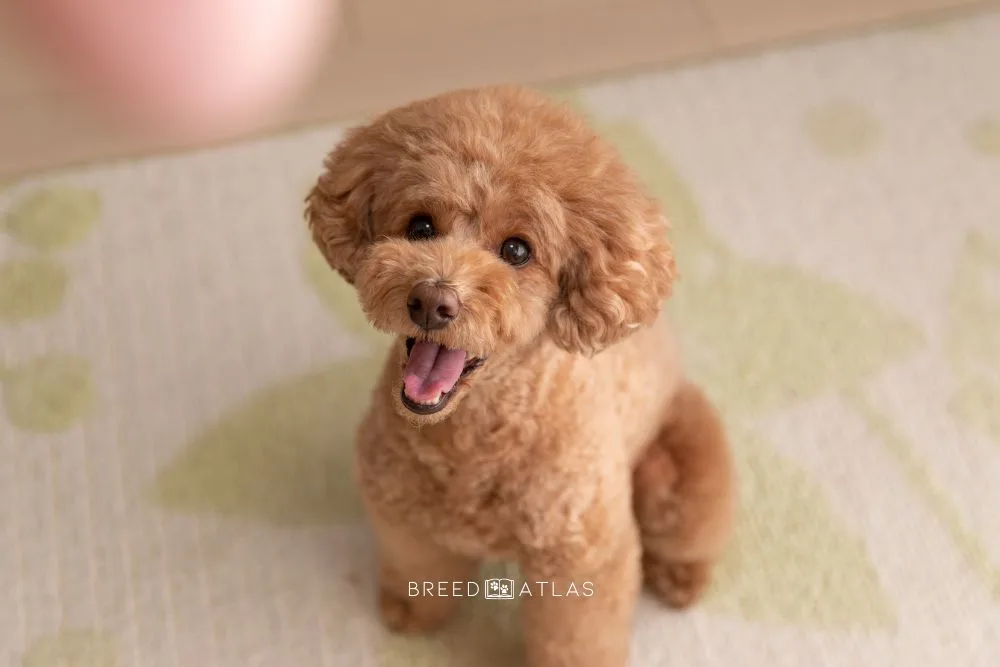
Finally, we have Toy Poodles. These are the smallest of all the recognized Poodle varieties, although they are not the smallest Poodle size – but more on this in a bit.
Toy Poodles are known for their small stature, and they are a popular choice for many celebrities, such as Grace Kelly, Orlando Bloom, and Katy Perry.
These pups reach around 10 inches in height and typically weigh 6-8 pounds.
They are true lap dogs, but still love a good hike. Due to their size, they are perfect for apartments, and it’s difficult to believe there’s anyone who lives in a large city that hasn’t seen someone walking a toy Poodle!
Poodle Sizes Not Recognized By The AKC
Now, as I have stated, there are several more Poodle sizes. These different types of Poodles aren’t recognized by the AKC, but they can still be found all around the US.
While you won’t be able to participate in dog shows, you might still enroll them in skill competitions, such as agility and obedience.
Also, it’s important to note that AKC isn’t the only kennel club in the world, although it is the main one in the US.
Different countries have different kennel clubs, many of which have different breed standards. Some breeders might adhere to European standards, for example, so just because they sell a dog that isn’t registered in the US doesn’t mean there’s something wrong with their breeding practices.
Still, the only way to fully utilize the benefits of having your own dog that is purebred is to find a Poodle puppy that has been AKC-registered.
Here are two more Poodle sizes that you might have heard of:
Moyen Poodle
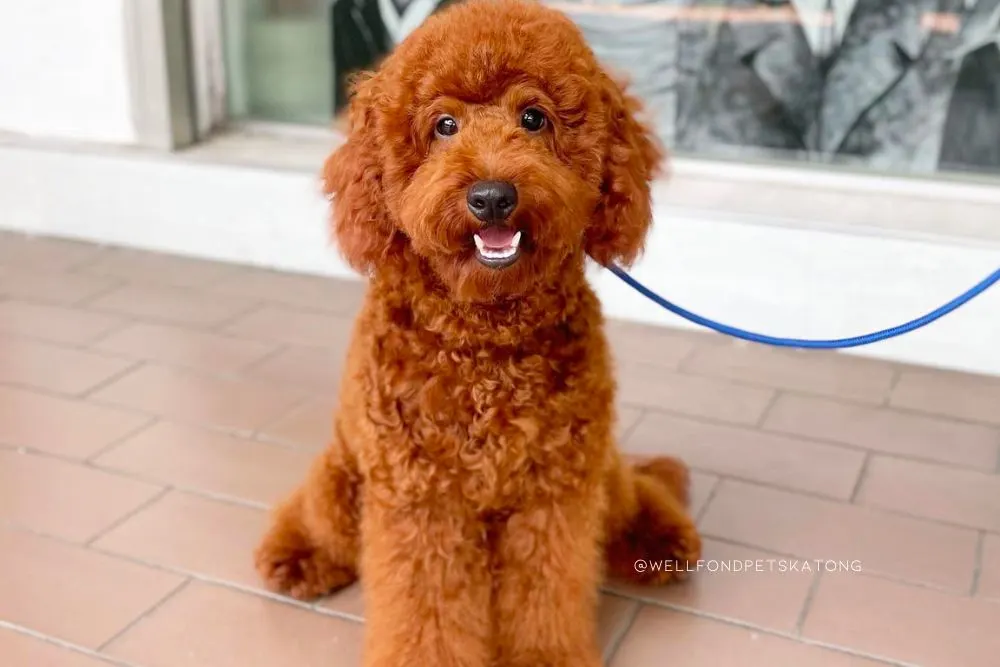
The Moyen Poodle is probably the most mysterious one of them all, as it might not be clear what size we’re talking about.
Well, if I tell you these pooches are also known as Klein or Medium Poodles, things might become easier to understand.
Moyen Poodles reach 15 – 20 inches in height and weigh approximately 15 to 35 pounds.
If you look at the AKC’s breed standard for Standard Poodles, you’ll notice that they state that any Poodle taller than 15 inches can be considered a Standard Poodle.
This means that you can still register your Moyen Poodle with the AKC, but you’ll have to call them Standard.
Also, Moyen Poodles are recognized by the Federation Cynologique Internationale (FCI) and most other Continental Europe kennel clubs. They are rather popular with European breeders, and they are easy to import to the US.
As a result, there are many Moyen Poodle breeders in the States, and many of them are legit – they simply cannot be registered with the AKC as they follow different standards. As long as they can pass the health screenings required by the AKC, you can purchase from them without any worries.
Moyen Poodles are a great choice for those who would want a larger Poodle than the Miniature one, but consider Standard Poodles too big for them or their living conditions.
Teacup Poodle
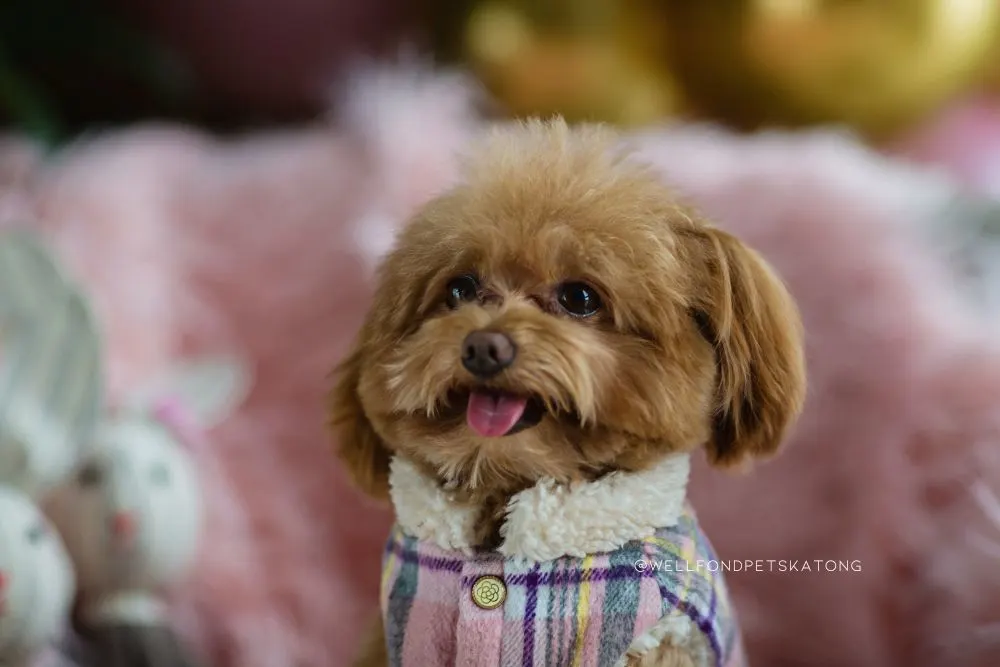
Finally, we have Teacup Poodles, the smallest Poodles of them all – and the most controversial ones.
Known for their small size, Teacup Poodles are even smaller than the Toy ones, as they can have a height of just 6 inches. Yes, these pups are the same size as many Chihuahuas! Although, no, they cannot fit inside a teacup, if that’s what you’ve been wondering.
They weigh between 3 and 8 pounds, which is less than an average cat’s weight!
Teacup Poodles aren’t recognized by any kennel clubs, and they are the result of shady breeding practices. Despite their cute, distinctive looks, I wouldn’t advise getting one, as they are very fragile.
Not to mention how you can never be entirely certain if they’re purebred or not!
Other Differences
I’ve talked about a little basic information about all five Poodle sizes, but I haven’t really stopped to compare all five in greater detail.
When it comes to appearance, there aren’t that many differences between all types of Poodles. All of these dogs have the same curly hair, cute eyes, and body proportions. All would look equally good with either of the many Poodle haircuts you can find online!
However, there might be other, more subtle differences in some other aspects.
Here’s what I mean:
Personality
Believe it or not, there are some slight differences in the personalities of all of these Poodles.
While most of these distinguishable traits don’t come directly from their size, the two are definitely connected.
All Poodles are great family dogs. They are friendly, loyal, and happy dogs that will want nothing more than to be by their owner’s side all day long.
They are also extremely smart, and they are constantly named as one of the smartest dog breeds in the world!
The size of dogs really doesn’t matter when it comes to wits, as all Poodle sizes are just as capable of learning various tricks and commands.
Still, here are some of the features that are unique to each size:
Standard
Standard Poodles have the confidence and calmness unique to large dog breeds. They are rather quiet, as they don’t feel the need to bark that often – although they’ll eagerly let you know if something’s wrong.
They have moderate energy levels and need about an hour of walking a day. Luckily, they don’t require any heavy exercise, although they could benefit from having a proper workout session every now and then.
These doggos are perfect companions for large families with other pets. Also, they are suitable for small children, as they are calm enough not to hurt them during playtimes.
Not to mention how they are big enough not to be hurt by young kids who still don’t know how to properly behave around a dog!
Moyen
Moyen Poodles have rather similar temperaments to Standard Poodles. This isn’t a surprise, as they can be registered under the same name.
The biggest difference many owners have reported lies in energy levels. Most dog lovers have agreed that Moyen Poodles have plenty of energy and that they require more activity compared to their larger counterparts.
This doesn’t mean they’re mischievous or that they don’t behave well. However, they might desire a bit more of your time, so if you work an 8-hour shift in the office, they might not be the best choice for you.
Miniature
While they share the intelligence and affectionate temperament of larger Poodles, these small dogs are extremely friendly. Some might behave like velcro dogs, following you around the house all day long!
They have moderate energy levels but might get tired quicker than Moyen and Standard pups, so they typically require shorter exercise sessions.
At the same time, they are more vocal. While not as big barkers as some other small dog breeds, or even as Toy Poodles, they’ll still love to loudly share everything with you – although I am certain you won’t be able to understand them most of the time.
Toy
Toy Poodles are charming and affectionate, and they are true lap dogs. They’ll want nothing more than to be next to you, and they’ll do all they can to achieve just that.
These are playful and friendly dogs that will always try to make everyone happy. They can be a bit vocal at times, but they lack the stereotypical feisty temperament many other toy dog breeds share.
Their energy levels are very high, and they’ll run around all the time! However, they might get tired during long walks, so get ready to carry them around a bit.
Despite their happy nature, they might not be the best choice for very young kids. Toddlers and young children might not know how to handle such small dogs and will act as if they were toys. This can be a recipe for a disaster.
Teacup
There are many ways in which Teacup Poodles might have different temperaments from other Poodle sizes. This is because they are often crossbreeds, so they might inherit temperamental traits from the other breed.
That aside, they should share the most temperamental traits with Toy Poodles, such as their friendliness and need for attention.
However, due to their small size and fragile health, they might require some extra care and maintenance. This can result in them being the clingiest of all Poodle types.
Grooming
Grooming requirements and the shedding amount might vary greatly depending on the dog’s size, so it’s no surprise that I have to mention it.
According to the Poodle Club of America and the AKC breed standard, Poodles can have two types of coats:
- Curly coats, of naturally harsh texture, dense throughout, and
- Corded coats, hanging in tight even cords of varying length; longer on mane or body coat, head, and ears; shorter on puffs, bracelets, and pompons.
They are also considered to have hypoallergenic coats as they don’t shed, but it’s important to keep in mind that it isn’t dog hair that allergy sufferers have a problem with, but rather dog’s dandruff, drool, and urine that can be spread around on dog hair.
Still, most Poodle owners who have dog allergies have reported having no issues with their curly-coated friends.
Here’s how to give proper care to various sizes of Poodles:
Standard
Due to their size, Standard Poodles have the most hair on them. This means they require daily grooming and brushing to keep their coats from matting.
Standard Poodles may need professional grooming every 4 to 6 weeks to keep their coat trimmed and neat.
Regular baths are also necessary to keep their coat clean and healthy, and their nails will require regular clipping.
Moyen
Due to their medium size, Moyen Poodles require a bit less care than Standard Poodles, but this is barely noticeable. They still have plenty of hair and you need to make sure it doesn’t tangle.
You might get away with brushing every couple of days, but they’ll still require pretty regular grooming.
They too should have monthly visits to the professional groomer who will give them a proper clean and cut.
Miniature
Miniature Poodles have a dense, curly coat that requires regular grooming to prevent matting and tangling. However, you probably won’t need to brush them more than several times a week, as they won’t have as much loose hair as their larger counterparts.
They may require less frequent grooming compared to Standard and Moyen Poodles but still benefit from regular maintenance. Professional grooming every 6 to 8 weeks is often recommended to trim their coat and keep them looking tidy.
Toy
Toy Poodles need a care routine that is pretty similar to miniature Poodles. This includes regular brushing to prevent mats and tangles.
However, as they have thinner, finer hairs, they might require slightly more frequent brushing. Their coat can become unkempt rather quickly, and matting can easily become challenging to deal with.
However, you don’t need to take them to the groomers that often. It’s enough if professionals get to trim their coats once every few months.
Teacup
Teacup poodles have the same coat type as toy poodles but in an even smaller size (unless they are a crossbreed, which will leave them with endless possibilities). This means regular grooming is a must.
They require daily brushing and overall cleaning to make sure their coat is in good condition.
Not just that, but you might want to take them to a professional groomer every 4 to 6 weeks. This is not only to make sure their coat is healthy, but an expert might also notice any skin issues or potential health problems you might be missing.
Diet And Nutrition
This one is probably very obvious, but different Poodle sizes have different dietary needs.
The main reason behind this is not just their size, but also their varying activity levels and health.
Overall, when feeding your pooch, you need to make sure to give them plenty of good nutrients and enough calories for their daily activities. You shouldn’t go overboard, however, as this can result in obesity.
Here’s what I mean:
Standard
Standard Poodles are the largest on our list and typically have higher energy requirements compared to smaller sizes.
They might benefit from foods specifically formulated for large breeds, but this isn’t a necessity as they aren’t as big as many other large dogs.
In general, they may require larger portion sizes and a diet rich in protein, healthy fats, and essential nutrients to support their overall health and well-being.
Moyen
Moyen Poodles don’t need the same kibbles as Standard ones, as they are small enough to have different dietary needs than large dogs.
In general, they don’t have any special dietary requirements, as they are generally healthy and of just the right size for most formulations of dog foods.
Just make sure not to give them too many calories. They are not the most active of dogs, so even though you might be tempted to feed them just as much as you would feed larger Poodles, this can lead to them being overweight.
Miniature
While Miniature Poodles are quite small, they have high energy levels, so they still need lots of good proteins and fats.
Look for foods formulated for small dog breeds that have protein sources listed as the first ingredient. This will provide them with just the right nutrients.
Obesity is another concern, so feed them in a few smaller portions and make sure to weigh them regularly.
Toy
Toy Poodles are smaller and have smaller energy requirements, so they don’t need as much protein as Miniature ones – although all dogs can benefit from a good protein source.
They may benefit from a diet formulated specifically for small or toy breeds, given to them in small portion sizes.
Toy Poodles may have a faster metabolism and may need smaller, more frequent meals to maintain stable energy levels throughout the day. Obesity isn’t as huge a concern as with most other Poodle sizes.
Teacup
The smallest size of Poodles is also a rather frail one, so make sure to get them the highest quality food possible.
They have very delicate digestive systems and may require a specialized diet formulated for toy or teacup breeds.
To preserve their guts, provide them with dog food that is highly digestible, with small kibble sizes or wet food options to prevent choking hazards.
Health
Poodles are generally considered a healthy breed. They don’t suffer from many health issues and have fairly long lifespans.
Of course, it’s important to purchase from a good breeder who will make sure you have a healthy dog. These dogs have been certified by the AKC or similar breed registry, which means they have good genes.
Unfortunately, any dog can get sick, and this includes our beloved Poodles.
Here are some health concerns you need to be wary of, depending on your dog’s size:
Standard
Standard Poodles are the healthiest type of Poodles, and they have a fairly long lifespan of up to 15 years.
However, they are prone to some health problems that tend to trouble many large dog breeds, such as hip dysplasia, elbow dysplasia, and Gastric Dilatation-Volvulus (bloat). They are also prone to other joint disorders, such as arthritis.
They may also be susceptible to eye disorders like progressive retinal atrophy (PRA) and cataracts.
The chances of these disorders increase as your dog ages, so don’t skip vet visits.
Moyen
Moyen poodles share some health concerns with both Standard and Miniature Poodles due to their medium size.
Similar to Standard Poodles, they might be prone to hip dysplasia, eye disorders, and joint issues.
Moyen poodles may also have a predisposition to certain genetic conditions common in smaller breeds, such as patellar luxation, also known as dislocating kneecap.
Their expected lifespan is pretty much the same as in Standard Poodles, so you can expect them to live around 15 years.
Miniature
Miniature Poodles are another healthy type of Poodle – which is a bit rare, as many miniature versions of breeds tend to be more sickly than standard ones. You can also expect them to live between 13 and 15 years.
However, they may have dental problems such as periodontal disease due to their small mouths and crowded teeth.
Miniature Poodles may also be susceptible to conditions like tracheal collapse and Legg-Calvé-Perthes disease.
Toy
Toy Poodles are generally not as healthy as Miniature, Moyen, and Standard Poodles, but they can still live a high-quality life, especially if purchased from the right breeders.
They are prone to health issues associated with their small size, including dental problems, patellar luxation, and hypoglycemia (low blood sugar).
Another condition they might be susceptible to is a collapsing trachea, a collapse of the windpipe that leads to breathing difficulties.
Finally, due to their small size, they are more prone to injuries.
Luckily, this doesn’t affect their lifespan too much, and they are expected to live 12 to 14 years.
Teacup
Teacup Poodles are not just the smallest, but also the most susceptible to various health conditions. This is because many Teacup Poodles are the result of breeding runts of the litter, so they might carry plenty of bad genes.
Their lifespan is 12 to 14 years, but they are more likely to have severe health problems from puppyhood, and this can greatly affect their quality of life.
They may suffer from hypoglycemia, dehydration, and developmental issues associated with being underweight or stunted.
Also, they might have fragile bones and organs, so they are extremely sensitive. Most Toy Poodle owners have had to rush them to the vet due to various injuries they’ve sustained.
This is why many people are against purchasing, selling, and breeding teacup variations of dogs.
Final Words
There you have it – everything you can expect with all Poodle sizes available.
It’s challenging to say which is the best one, as all have their own advantages and downsides.
In general, if you live in a small apartment, I can see why purchasing a smaller Poodle variety might be the preferred option.
On the other hand, people with large backyards would probably have no problems with providing their Standard Poodle with everything he or she might need.
No matter the size, all Poodles are one of the best four-legged companions anyone can get. Their intelligent expression mixed with adorable appearance and hypoallergenic coats make them perfect for just about anyone!
I hope this article has helped teach you more about the wonderful world of Poodles!
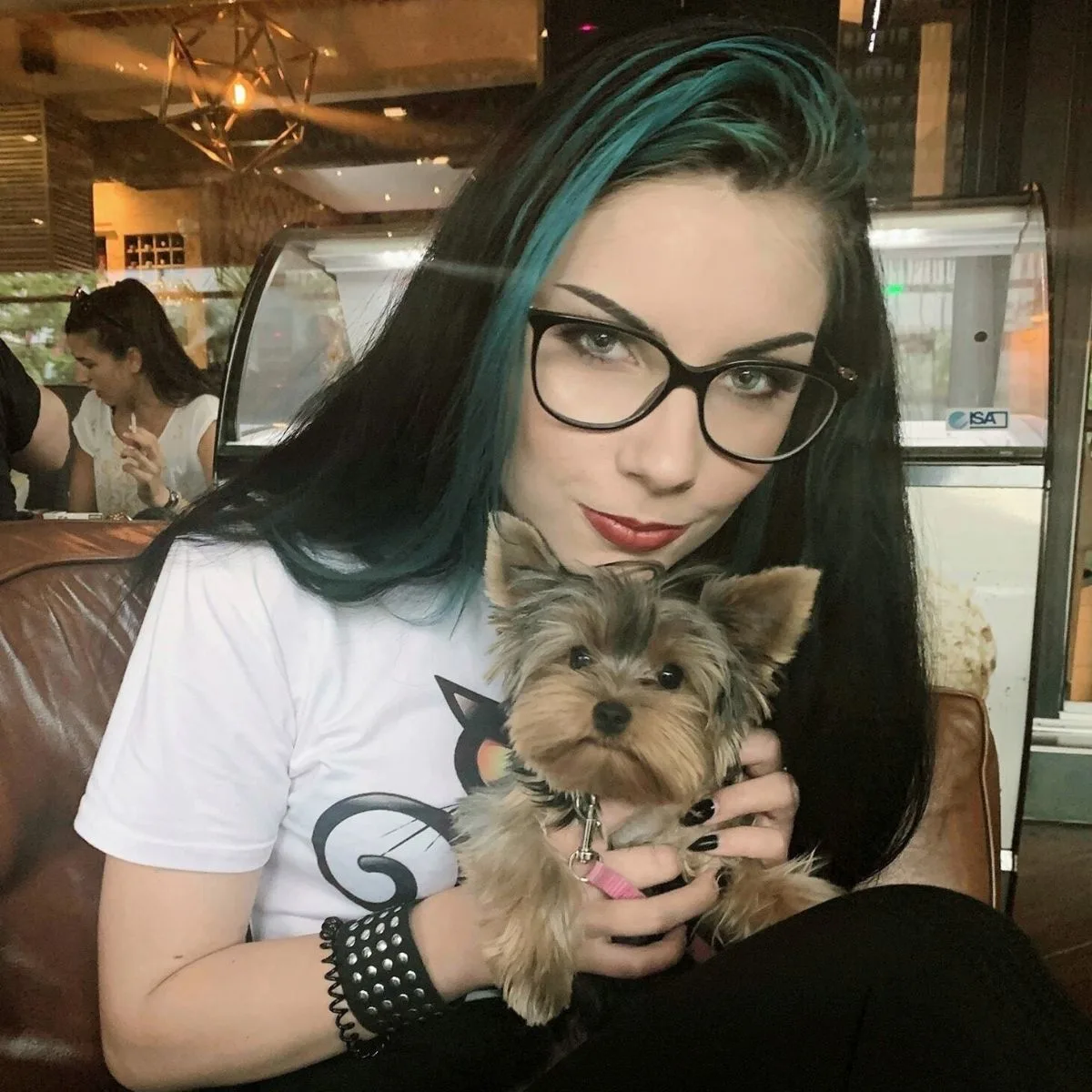
Vanja’s passion for writing started at an early age, which is why she pursued Journalism as her college degree. She can research any topic and find all the information before you bat an eye, which is a great thing for her job but a terrible one for her husband.
Even as a young child, she fell in love with everything fluffy – but dogs have a special place in her heart due to her childhood companion, a Corgie named Archie.
Motivated by her experiences and driven by a desire to give back to her four-legged companions, she spends her free time volunteering at a local dog shelter.
